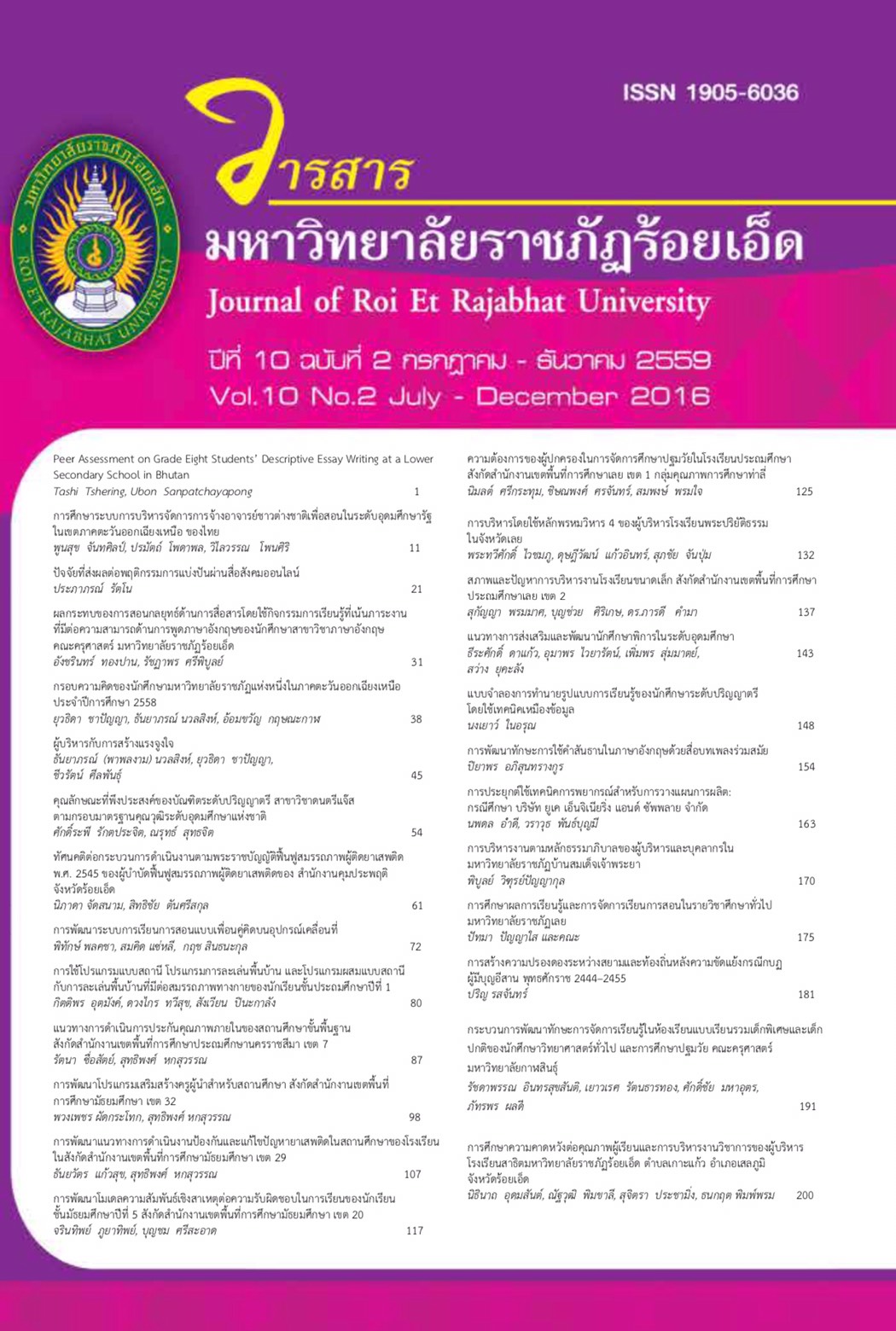Administrator and Motivation Creation
Keywords:
Motivation, Motivation Creation, AdministratorAbstract
Motivation is one of important factors affecting human behaviors as it stimulates desires in people to be willing, and committed to a job and make an effort to attain a goal. Currently, government and private’s organizations are interested in feeling of their staff. It is necessary for organizations’ administrators to promote and create motivation to optimize the effectiveness of work performance. Moreover, work motivation can direct an effective administration of effective leaders. Accordingly, administrators or leaders should find out effective techniques to create motivation of their personnel in order to reach organizational goal effectively.
References
โชติกา ระโส. (2555). แรงจูงใจในการปฏิบัติงานของบุคลากร มหาวิทยาลัยราชภัฏนครสวรรค์. ปริญญานิพนธ์ กศ.ม. (การอุดมศึกษา). กรุงเทพฯ : มหาวิทยาลัยศรีนครินทรวิโรฒ ประสานมิตร.
นภวรรณ คณานุรักษ์. (2554, มกราคม–มีนาคม). “บทบาทผู้นําองค์กรที่มีพนักงานวิชาชีพ,” วารสารวิชาการ หอการค้าไทย. 31(1).
ปรียาพร วงศ์อนุตรโรจน์. (2553). จิตวิทยาการบริหารงานบุคคล. กรุงเทพฯ : ศูนย์สื่อเสริมกรุงเทพ.
ไพศาล มะระพฤกษ์วรรณ และคณะ. (2542). การจัดและพัฒนาองค์การทางการศึกษา. กรุงเทพฯ: มหาวิทยาลัยรามคําแหง
ยงยุทธ พรหมณี. (2559). ทักษะการจัดการทรัพยากรมนุษย์ของผู้นํา : การจูงใจ. (ออนไลน์). แหล่งที่มา : www.pncc.ac.th/pncc/wrod/re/r6.doc .
สมยศ นาวีการ. (2545). การพัฒนาองค์การและการจูงใจ. กรุงเทพฯ : บรรณกิจ 1991.
อารีย์ พันธ์มณี. (2546). จิตวิทยาสร้างสรรค์การเรียนการสอน. กรุงเทพฯ : ใยไหม ครีเอทีฟ กรุ๊ป.
อุทัย หิรัญโต. (2543). การปกครองท้องถิ่น. กรุงเทพฯ : โอเดียนสโตร์.
Crewson, P.E. (1997). “Public–Service Motivation: Building Empirical Evidence of Incidence and Effect,” Journal of Public Administration Research and Theory. 7(4).
Herzberg, F., Mausner, B., & Snyderman, B.B. (1959). The motivation to work. New York : John Wiley & Sons.
Hodgetts, R.M. (1999). Modern Human Relations at work. New York : Dryden Press, Harcourt Brace College.
Hollyforde, S. & Whiddettt, S. (2002). “How to Nurture Motivation,” People Management. 8(4) : 52-53.
Hoy, W.K. & Miskel, C.G. (2008). Educational Administration : Theory, research and practice. Boston : McGraw Hill.
Jurkiewicz, C.L., Massey, Jr., Tom K., & Brown, R.G. (1998). “Motivation in Public and Private Organizations : A Comparative Study,” Public Productivity and Management Review. 2(3).
Lindner, JR. (1998). Understanding Employee Motivation. 36(3). (online). Available : www.joe.org/joe/ 1998june /rb3.php.
Maslow, A. (1970). Motivation and personality. New York : Harper & Row. McClelland, D.C. (1962). “Business, Drive and National Achievement,” Harvard Business Review. 40 : 99– 112.
Pounder, J.S. (2001). “New Leadership and University Organizational Effectiveness : Exploring the Relationship,” Leadership & Organization Development Journal. 22(6).
Downloads
Published
How to Cite
Issue
Section
License
บทความที่ได้รับการตีพิมพ์เป็นลิขสิทธิ์ของวารสารมหาวิทยาลัยราชภัฎร้อยเอ็ด
ข้อความที่ปรากฏในบทความแต่ละเรื่องในวารสารวิชาการเล่มนี้เป็นความคิดเห็นส่วนตัวของผู้เขียนแต่ละท่านไม่เกี่ยวข้องกับมหาวิทยาลัยราชภัฎร้อยเอ็ด และคณาจารย์ท่านอื่นๆในมหาวิทยาลัยฯ แต่อย่างใด ความรับผิดชอบองค์ประกอบทั้งหมดของบทความแต่ละเรื่องเป็นของผู้เขียนแต่ละท่าน หากมีความผิดพลาดใดๆ ผู้เขียนแต่ละท่านจะรับผิดชอบบทความของตนเองแต่ผู้เดียว





